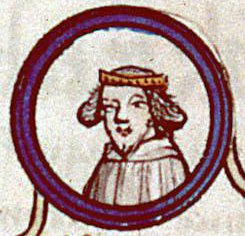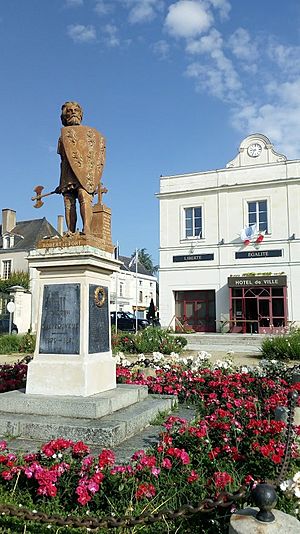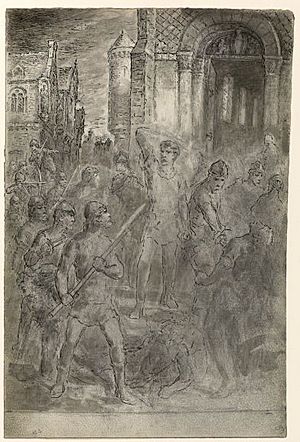Robert the Strong facts for kids
Quick facts for kids Robert the Strong |
|
|---|---|
 |
|
| Robert the Strong's image in a genealogy of French kings (c. 1384) | |
| Spouse(s) | Adelaide of Tours |
| Issue | |
| Odo (or Eudes) Robert I of France |
|
| Noble family | Robertians |
| Father | Robert III of Worms (speculated) |
| Born | c. 830 |
| Died | 2 July 866 (aged 35–36) |
Robert the Strong (French: Robert le Fort) was an important leader in a kingdom called West Francia. This kingdom was a part of what is now France. Robert lived from about 830 to 866. He was the father of two kings: Odo and Robert I of France. His family, the Robertians, is named after him.
In 853, King Charles the Bald chose Robert to be a missus dominicus. This was a special royal agent who oversaw different areas. Robert the Strong was also the great-grandfather of Hugh Capet. This means he was an ancestor of all the Capetian kings who later ruled France.
Robert's Early Life and Power
We do not know much about Robert the Strong's parents. Some people think his father was Robert III of Worms. His family, the Robertians, may have come from a region called Hesbaye, which is now in Belgium. However, these ideas are not fully proven.
One idea is that Robert's family moved from East Francia (which is now Germany) to West Francia. This happened during the time of King Louis the German. When they arrived, King Charles the Bald welcomed them. He gave Robert control of the Marmoutier Abbey in 852.
In 853, King Charles gave Robert even more power. He made him a missus dominicus in areas like Maine, Anjou, and Touraine. This gave Robert real control over a large area called the ducatus Cenomannicus. This area was centered around Le Mans. It was also known as the old kingdom of regnum Neustriae.
Robert became powerful at the expense of another family, the Rorigonids. King Charles wanted to reduce their power. He also wanted Robert to protect Neustria from attacks. These attacks came from Viking raiders and people from Brittany.
Robert's Rebellion
In 858, Robert joined a rebellion against King Charles the Bald. He teamed up with the Bretons, led by their king, Salomon. Robert also led the Frankish nobles from Neustria. They invited King Louis the German to invade West Francia.
The rebellion started because King Charles made an alliance with Erispoe, King of Brittany. Charles also gave his son, Louis the Stammerer, control of the regnum Neustriae. These actions reduced the power of both Salomon and Robert.
Before this, Charles had given Robert the counties of Autun and Nevers in Burgundy. In 856, Robert had even defended Autun from Louis the German. But after Erispoe was killed in 857, Robert and Salomon rebelled.
In 858, Robert's forces drove Louis the Stammerer out of Le Mans. Later that year, Louis the German reached Orléans. He met with leaders from Brittany and Neustria, as well as Pepin II of Aquitaine.
In 861, King Charles made peace with Robert. He then appointed Robert as Count of Anjou. After this, Robert successfully defended the northern coast from a Viking invasion.
In 862, Charles gave his son, Louis the Stammerer, control of the Saint Martin of Tours abbey. This was a good gift, but it was much smaller than the kingdom Louis had received earlier. So, young Louis rebelled. He became friends with Salomon, who gave him troops. Louis then started a war against Robert.
In 862, two Viking fleets arrived in Brittany. One had been forced out of the Seine River by Charles the Bald. The other was returning from a trip to the Mediterranean Sea. Salomon hired the Mediterranean fleet to attack the Loire valley in Neustria. Robert captured twelve of their ships. He killed everyone on board except a few who escaped.
Robert then hired the Vikings from the Seine to attack Salomon's land. He paid them 6,000 pounds of silver. Robert's goal was to stop the Vikings from helping Salomon. He likely collected a lot of money in taxes to pay the Vikings. This payment, called a Danegeld, was to keep them out of Neustria.
However, peace between the Franks and the Vikings did not last long. In 863, Salomon made peace with the Vikings. But the Vikings, now without enemy lands to raid, started attacking Neustria. King Charles then made Robert the Lay abbot of the important St. Martin Abbey at Tours.
In his later years, Robert fought against Pepin II. In 863, he again defended Autun from Louis the German. He also fought in Neustria in 865 and again in 866. This was shortly before his death. He dealt with Bretons and Vikings who were raiding the area around Le Mans.
Death and Legacy
On July 2, 866, Robert the Strong was killed. This happened at the Battle of Brissarthe. He was defending Francia from a combined group of Breton and Viking raiders. These raiders were led by Salomon, King of Brittany and the Viking leader Hastein.
During the battle, the Viking commander was trapped in a nearby church. Robert took off his armor to prepare to attack the church. But the Vikings launched a surprise attack. Robert died in the fight that followed.
He left behind a nine-year-old son, Odo. Odo would later become King of France. Robert's brave victories against the Vikings made him famous. People called him "a second Maccabaeus" in a historical record called the Annales Fuldenses. This meant he was seen as a great hero and defender.
Family
Robert married Adelaide of Tours. She was the daughter of Hugh of Tours. They had two sons:
- Odo of France (about 857–898), who became King of West Francia.
- Robert I of France (about 866–923), who also became King of West Francia.
See also
 In Spanish: Roberto el Fuerte para niños
In Spanish: Roberto el Fuerte para niños




